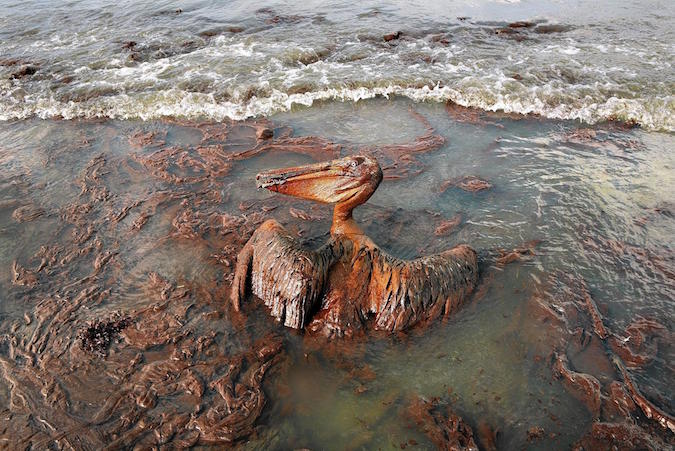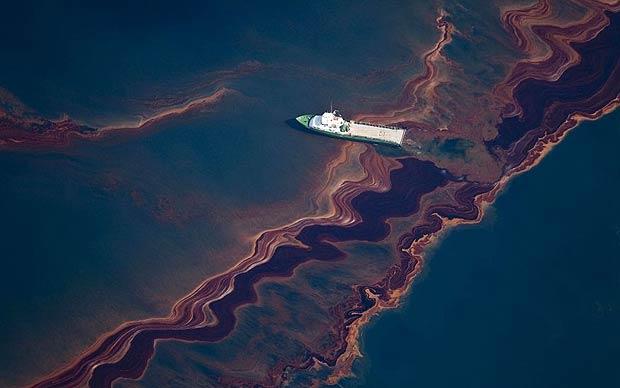Dispersants only succeeded in disappearing the oil, biodegradation was not ‘ramped up’ by natural microbes
GreenMedInfo Research Group
GreenMedInfo.com
That’s the verdict (see title above) from a recent study conducted by marine scientist Samantha Joye. After duplicating the conditions at her University of Georgia laboratory, Joye demonstrated that those particular species of bacteria which like to eat petroleum did not characteristically multiply when eating dispersed oil. Their naturally occurring proliferation when eating untreated oil was completely curtailed when replaced with dispersed oil.
Because the marinobacters (oil-eating bacteria), as they are called, reacted so differently to the dispersant-laden petroleum, the obvious question is why. During the 2010 BP oil spill, authoritative information surfaced on the EPA website which indicated that dispersed oil was significantly more toxic that untreated crude oil.[1] Many armchair researchers at that time surmised that the dispersed oil had been so altered that the marinobacters either might not recognize it, or would find it too toxic to eat.
It looks like their intuition may have been right on target, particularly in view of the fact that oil, which has not interacted with Corexit, appears to be much more delectable to the same bacteria. The bigger concern, however, because of the extraordinary volume of dispersant used in the Gulf of Mexico (GOM), is: Where is all the spilt oil?
In other words, since the oil was effectively disappeared from the surface of the GOM, where exactly is it now? It appears that Corexit[2] did not really correct the situation; rather, it only disappeared the oil. Does that mean massive amounts of oil are now sitting on the seafloor, or in a chemically altered condition floating in the water columns?
The Name – COREXIT – is supposed to make you think it “Corrects It!”
Clearly, the most serious predicament is this: that the dispersed oil has been so altered as it sits, as if in a colloidal solution, in the water columns that it can never be properly remediated. This would be the worse case scenario because of the marine life that would be forever exposed to it. Endlessly swimming in the GOM waters, all fish would be exposed to the toxic dispersed oil, as would all the other sea life in the food chain where the toxic hydrocarbons can bioaccumulate over many years if not decades.
______________________________________________________________
Factoid:
Corexit’s interaction with petroleum is particularly troubling in that dispersed oil causes a much higher rate of mortality in fish than either the oil or dispersant alone. As compared with only oil, Corexit-laden oil is four times more lethal; dispersed oil is ten times more deadly than the dispersant alone. (See detailed analysis below)
(Source: Environmental and Health Impacts of the BP Gulf Oil Spill)
______________________________________________________________
 Not only is dispersed oil more toxic to fish than oil, so is straight Corexit. Hence, the millions of gallons of Corexit that were used during and after the spill, which never interacted with petroleum, also pose serious health risks. What follows are three (3) statements about oil, dispersant (Corexit 9500) and dispersed oil which appeared on the EPA website during the Gulf spill.
Not only is dispersed oil more toxic to fish than oil, so is straight Corexit. Hence, the millions of gallons of Corexit that were used during and after the spill, which never interacted with petroleum, also pose serious health risks. What follows are three (3) statements about oil, dispersant (Corexit 9500) and dispersed oil which appeared on the EPA website during the Gulf spill.
(1) 10.72 parts per million (ppm) of oil alone will kill 50% of the fish test species in a normal aquatic environment within 96 hours.
(2) 25.20 parts per million of dispersant (Corexit 9500) alone will kill 50% of the fish test species in a normal aquatic environment within 96 hours.
(3) 2.61 parts per million of dispersed oil (Corexit-laden) alone will kill 50% of the fish test species in a normal aquatic environment within 96 hours.
(Source: US Environmental Protection Agency)
Alarming update just published by the mainstream media
The article that is posted in its entirety below lays bare what many health advocates and environmental activists knew during the height of the BP Gulf oil spill. First, that Corexit didn’t really correct the problem; and, that Corexit quite likely made it much worse. Not only is this highly toxic dispersant harmful to fish as the test studies proved, but it is also quite detrimental to human life. As reported by the media, Corexit 9527A was additionally used during the BP spill. The Corexit 9527A formulation contains the scientifically documented toxin 2-Butoxyethanol.[3]
“One of the dispersants used at the BP spill, Corexit 9527A, contains the toxin 2-Butoxyethanol which “may cause injury to red blood cells (hemolysis), kidney or the liver” with “repeated or excessive exposure,” according to the manufacturer’s safety data sheet.”
(Source: Center for Biological Diversity)
Conclusion
By utilizing the pharmaceutical approach in the Gulf of Mexico, BP and the U.S. Coast Guard superficially treated the symptoms by quickly disappearing the surface oil. Rather than removing the leaked oil via traditional methods, and safely processing it in a controlled environment, their immediate goal was “out of sight, out of mind”. In this way the media flyovers would not have miles of oil slicks to photograph. Keeping such disturbing images off the fronts pages of American newspapers and alternative news websites was BP’s paramount concern, as it was the U.S. Federal Government’s.
Many of us know that the pharmaceutical approach will often make the problem worse, just as radical surgery, chemo and radiation therapy will frequently kill a cancer patient. In other words the cancer may be wiped out, but the severe collateral damage from the allopathic treatments to the individual’s organ systems may bring about a premature, and sometimes very painful, death.
Similarly, the GOM was made to look cleaned up through the liberal and often unreported use of dispersants, but the oil is still there. Of much greater consequence, the dispersant and the dispersed oil are still very much there … somewhere. The real question now is: Where is the dispersed oil? And, how can it be practically cleaned up? Can the GOM ever be cost effectively remediated given that the dispersed oil may exist in a state that is practically inaccessible or impossible to find?
There is one very silver lining in this extremely dark cloud known as the BP Gulf oil spill. Nations the world over have systematically delisted and/or outlawed the use of dispersants in their territorial waters and on their land masses. A literal sea change has occurred in governmental oil spill response worldwide in the wake of all the sobering revelations regarding Corexit. Once the environmental dangers and health risks associated with dispersants became widely disseminated, no one wants to use it … except the U.S. government.
Dispersant Use Like Corexit Sees Precipitous Decline Worldwide
GreenMedInfo Research Group
November 12, 2015
References
[2] http://www.greenmedinfo.com/toxic-ingredient/corexit-9500
[3] http://www.greenmedinfo.com/toxic-ingredient/2-butoxyethanol
~~~~~~~~~~~~~~~~~~~~~~~~~~~~~~~~~~~~~~~~~~~~~~~~~~~~~~~~~~~~~~
Study finds dispersants did not help oil degrade in BP Deepwater Horizon spill
By Seth Borenstein, AP Science Writer
![A plane sprays dispersant as it passes over an oil skimmer in the Gulf of Mexico near the coast of Louisiana after the BP Deepwater Horizon oil spill. [Associated Press]](https://stateofthenation2012.com/wp-content/uploads/2015/11/dispersant111015_16259025_8col.jpg)
A plane sprays dispersant as it passes over an oil skimmer in the Gulf of Mexico near the coast of Louisiana after the BP Deepwater Horizon oil spill. [Associated Press]
WASHINGTON — The chemical sprayed on the 2010 BP oil spill may not have helped crucial petroleum-munching microbes get rid of the slick, a new study suggests.
And that leads to more questions about where much of the Deepwater Horizon oil spill went. If the new results are true, up to half the oil can’t be accounted for, said the author of a new study on the spill in the Gulf of Mexico.
After the 172 million gallon spill, the chemical dispersant Corexit 9500 was applied by airplane on the slick to help it go away and help natural microbes in the water eat the oil faster. The oil appeared to dissipate, but scientists and government officials didn’t really monitor the microbes and chemicals, said University of Georgia marine scientist Samantha Joye.
5 YEARS AFTER SPILL: Gulf of Mexico is resilient, but scarred
So Joye and colleagues recreated the application in a lab, with the dispersant, BP oil and water from the gulf, and found that it didn’t help the microbes at all and even hurt one key oil-munching bug, according to a study published Monday in the journal Proceedings of the National Academy of Sciences.
“The dispersants did a great job in that they got the oil off the surface,” Joye said. “What you see is the dispersants didn’t ramp up biodegradation.”
In fact, she found the oil with no dispersant “degraded a heckuva lot faster than the oil with dispersants,” Joye said.
Joye’s team chronicled nearly 50,000 species of bacteria in the gulf and what they did to the water with oil, and water with oil and dispersant.
RELATED: Despite concerns, dispersant use continued on gulf oil spill
One of the main groups of oil munchers are fat little sausage-shaped bacteria called marinobacters, Joye said. They eat oil all the time and comprise about 3 percent of the bacteria in normal water. But when there’s oil, they eat and multiply like crazy until they are as much as 42 percent of the bacteria, Joye said.
But when the dispersant was applied, they didn’t grow. They stayed around 3 percent, Joye said.
Instead, a different family of bugs called colwellia multiplied more, and they don’t do nearly as good a job at munching the oil, Joye said. She theorized that for some reason the dispersant and marinobacters just don’t work together.
So if the oil wasn’t degraded by the bacteria, the question remains: Where did it go? Joye guesses it might still be on the floor of the gulf.
Outside scientists Jeff Chanton and Ian MacDonald of Florida State University said the study seemed to make sense. Chanton called the results important and surprising.
The National Oceanic and Atmospheric Administration welcomed the study and will evaluate to determine how well dispersants work in the future, said agency spokeswoman Keeley Belva.
—
Originally published at:
http://www.greenmedinfo.com/blog/study-finds-dispersants-did-not-help-oil-degrade-bp-deepwater-horizon-spill


